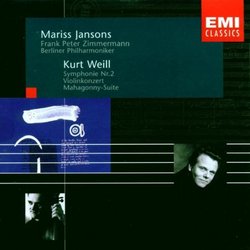| All Artists: Weill, Zimmermann, Jansons, Bpo Title: Weill: Symphony No.2, etc. Members Wishing: 0 Total Copies: 1 Label: Angel Records Original Release Date: 1/1/1997 Re-Release Date: 9/8/1998 Genre: Classical Styles: Opera & Classical Vocal, Forms & Genres, Concertos, Historical Periods, Modern, 20th, & 21st Century, Instruments, Strings, Symphonies Number of Discs: 1 SwapaCD Credits: 1 UPC: 724355657329 |
Search - Weill, Zimmermann, Jansons :: Weill: Symphony No.2, etc.
 | Weill, Zimmermann, Jansons Weill: Symphony No.2, etc. Genre: Classical
![header=[] body=[This CD is available to be requested as disc only.]](/images/attributes/disc.png?v=430e6b0a) ![header=[] body=[This CD is unavailable to be requested with the disc and back insert at this time.]](/images/attributes/greyed_disc_back.png?v=430e6b0a) ![header=[] body=[This CD is unavailable to be requested with the disc and front insert at this time.]](/images/attributes/greyed_disc_front.png?v=430e6b0a) ![header=[] body=[This CD is unavailable to be requested with the disc, front and back inserts at this time.]](/images/attributes/greyed_disc_front_back.png?v=430e6b0a) |
Larger Image |
CD Details |
CD ReviewsFantastic instrumental Weill, now reissued R. Hutchinson | a world ruled by fossil fuels and fossil minds | 04/25/2010 (5 out of 5 stars) "This great set by the Berlin Philharmonic, Mariss Jansons and Frank Peter Zimmerman has now been reissued in an EMI Gemini set, along with a disc of vocal Weill music. Don't miss it!
I finally picked up Kurt Weill's famous Threepenny Opera (1988 recording with Ute Lemper & the RIAS Berlin a couple of years ago as I started to seriously investigate 20th century German classical music. Weill's collaboration with Bertolt Brecht, who by now is widely considered the greatest playwright of the 20th century, was a smash hit in Berlin in 1928, and at least two Weill-Brecht songs became widely known in the U.S. -- "Mac the Knife" from "The Threepenny Opera," recorded by Frank Sinatra and Jimmie Dale Gilmore among dozens of others, and "Alabama Song" from "Mahagonny-Songspiel" (1927), which I and countless others first heard sung by the Doors. Weill was Jewish and a leftist, a member of the November Group (of radical artists) in the 1920s Weimar Republic, and so he fled Germany, staying in Paris briefly before settling in the U.S. where he had a successful career writing Broadway musicals before he died of a heart attack just after his 50th birthday in 1950. Weill was trained as a classical composer, and produced a small body of instrumental work, mainly before his success with opera and musicals. Three instrumental works by Weill are performed to perfection by the Berlin Philharmonic led by Mariss Jansons. The "Symphony No. 2" (27'10 -- 1934) in four movements leads off, followed by the "Concerto for violin and wind orchestra" (26'07 -- 1924) from ten years earlier, played magnificently by Frank Peter Zimmerman, and finally comes the "Rise and Fall of the City of Mahagonny Suite" (17'15 -- 1930), with several quite hummable tunes including "Alabama Song." Weill wrote two symphonies, the first an early one-movement expressionist piece. He wrote the "Symphony No. 2" in Paris in 1934, and it was his last instrumental composition. It is a very strong work, conveying the Weimar mood with the Left facing off against the Right (sorry Glenn Beck, it was the RIGHT WING that took power in 1933!), using the four-movement symphonic form to clearly communicate with the working class public. The earlier violin concerto is a great showpiece for Zimmerman, and it uses an unusual wind orchestra with no strings. Also of its time, it combines a Second Vienna School influence with the newest neoclassical influence of Stravinsky. Based on these two works, it is clear that Weill could have had a successful career pursuing these classical forms, but he followed his success and moved toward songwriting for staged dramas. The "Mahagonny Suite" is great, from the expanded work of 1930, again played to the hilt by the Berlin Philharmonic. I have to think that this recording session brought out the best in all concerned, Berlin's premiere orchestra bringing to light rarely heard works from Weimar-era Berlin." |

 Track Listings (16) - Disc #1
Track Listings (16) - Disc #1